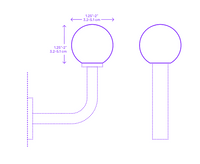The diameter of a handrail might seem like a small detail, but it plays a crucial role in its overall functionality. A well-chosen diameter ensures that the handrail is easy to grip, which is essential for safety and preventing slips and falls—especially for children, seniors, and individuals with limited mobility. At the same time, the right size also contributes to comfort, making it easy for anyone to use the handrail without strain or awkwardness.
Beyond safety and comfort, handrail diameter affects the visual appeal of your space. A handrail that's too large can look bulky and out of place, while one that's too small might appear flimsy or fail to complement the design of your stairs or railing. Striking the right balance between safety, comfort, and design is key to choosing a handrail that works well in both form and function.
This guide will walk you through everything you need to know about selecting the appropriate handrail diameter. We'll cover:
-
Technical Standards: The official guidelines and regulations, such as those from the International Building Code (IBC) and Americans with Disabilities Act (ADA), dictate the ideal sizes for handrails.
-
Practical Tips: How to choose the right size and material based on your specific needs and the users of the handrail.
-
Design Considerations: Ways to ensure your handrail complements the aesthetic of your home or building while still meeting functional requirements.
Handrail Diameters: Building Codes and Regulations
Circular Handrails
-
The International Building Code (IBC) and the Americans with Disabilities Act (ADA) both recommend a diameter between 1.25 inches and 2 inches for circular handrails.
-
This size range ensures the handrail is easy to grip for most people, accommodating various hand sizes without being too small or too bulky.
-
A consistent, rounded shape also reduces the risk of injuries, as there are no sharp edges or awkward angles.

Non-Circular Handrails
-
According to standards, or handrails that aren’t perfectly round, the perimeter dimensions (the distance around the handrail’s outer edge) should fall between 4 inches and 6.25 inches.
-
Additionally, the maximum cross-section dimension—the thickest point of the handrail—should not exceed 2.25 inches.
-
These measurements ensure that the handrail is still easy to grasp and safe to use, even if it has a more decorative or unique shape.
-
Non-circular handrails are often chosen for aesthetic reasons, but they still need to meet these standards to maintain functionality and safety.
I think it’s important not to skip over this information, even if it seems unimportant at first. These details play a big role in keeping people safe, ensuring accessibility, and staying compliant with regulations—things you definitely don’t want to overlook.

Image source: U.S. Access Board: Guide to the ADA Accessibility Standards
Material and Finish Considerations
Handrails are often made from wood, metal, or vinyl, and the material affects the diameter. Wood is easy to shape and works well for standard sizes. Metal, like stainless steel or wrought iron handrails, is strong and durable but needs precise sizing. Vinyl is lightweight and low-maintenance but must still meet size standards for safety.
How do finishes affect grip and safety?
The finish of a handrail - whether smooth, textured, or matte - can impact both grip and safety. A smooth finish feels comfortable and looks polished but may become slippery, especially if wet. Textured finishes provide extra grip, making them a good choice for areas prone to moisture or heavy use. Matte finishes reduce glare and are less likely to feel slippery compared to glossy ones.
Aesthetic and Design Integration
The size of a handrail should match the architectural style of your space. For modern designs, slimmer handrails with a diameter closer to 1.25 inches often work best for a sleek and minimalist look. Traditional styles might benefit from slightly larger, more decorative handrails, while industrial designs often feature sturdy, thicker handrails for a bold appearance. To put it simple, choose a size that complements your overall decor—consider pairing slimmer handrails with clean, simple lines or using larger ones to match ornate or rustic features.
Safety and Practical Tips
It’s important to check that your handrail has smooth, rounded edges to prevent injuries. Sharp edges or rough spots can cause cuts, scratches, or discomfort when gripping the rail. Over time, wear and tear can create splinters in wood or jagged edges in metal, making the handrail unsafe to use.
Maintenance
Keeping your handrails in good shape is important to make sure they’re safe, easy to use, and meet standards. For example, dirt and grime can build up over time, making the rail slippery. A simple wipe-down with soap and water every now and then can help keep the grip secure. If you have metal handrails outside, check for rust—especially after rainy seasons. Adding a rust-resistant coating can go a long way in preventing damage.
For wooden handrails, it’s a good idea to sand and refinish them if you notice any rough spots or splinters. Don’t forget to check if the rail feels loose or wobbly. Tightening screws or replacing worn-out brackets can make a big difference. And if you’ve made any repairs or changes, double-check that the height and size still meet safety standards.
Conclusion
I hope this guide has helped you feel more confident in choosing the right size for your handrail. Whether you're focusing on safety, comfort, or design, getting the right fit is key to making your space both functional and stylish. If you have any questions or need more guidance, feel free to reach out, we at Steel Impression are always happy to help.









